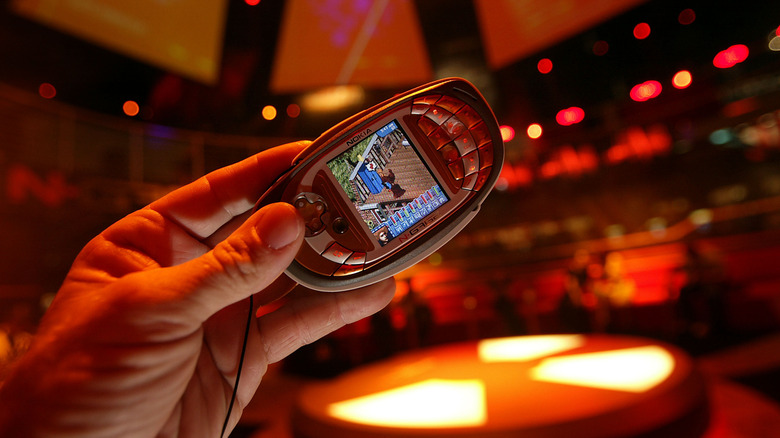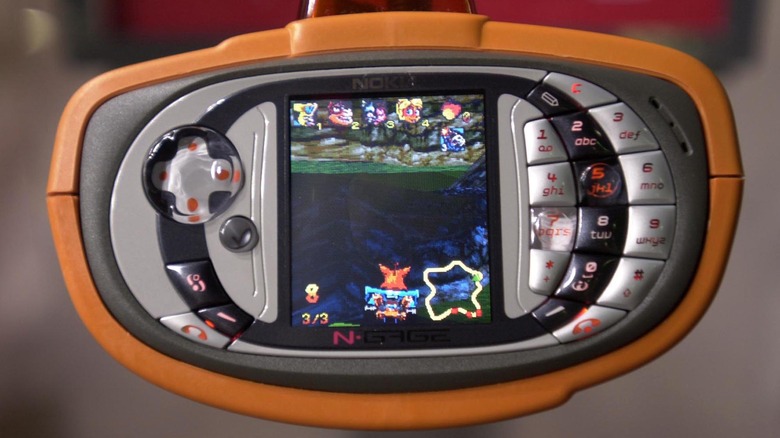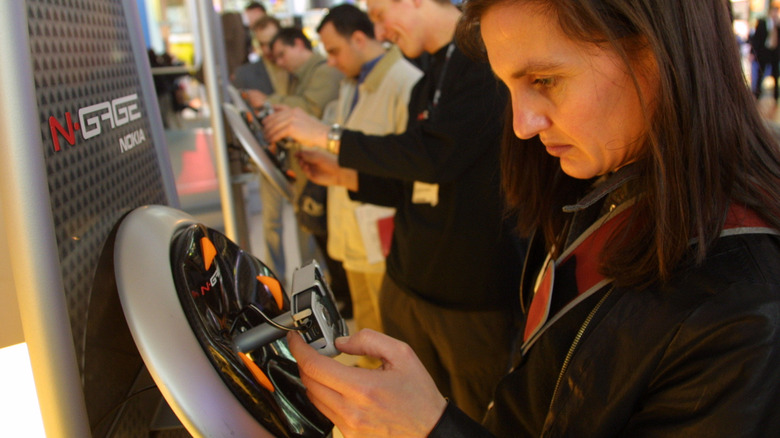Why The Nokia N-Gage Was A Complete Failure
The Nokia N-Gage was among the first gaming phones ever made, featuring promising hardware that would've been revolutionary ... until it became a total failure, that is. In 2003, the Finnish telecommunications company bet big on taking both the cellphone and budding gaming industries by storm. Its secret weapon came in the form of the Nokia N-Gage phone — a cellphone and portable handheld gaming device hybrid aiming to oust Nintendo's fan-favorite Game Boy Advance. Of course, phones with gimmicky hardware tend to flop big time — something Amazon learned the hard way with its Fire phone.
However, Nokia had a lot of faith in its product, all while expending a lot of resources in the process (via Wired). This included allocating a multi-million dollar budget solely on its marketing, signing deals with various game publishers, and even branching out beyond cellphone shops and into gaming retailers. Despite critics already lambasting the N-Gage prior to its release, Nokia still pushed to sell its first gaming phone for about $300, with games going for $30 apiece. It might sound like Nokia was biting off more than it could chew by releasing a product over $100 more expensive than its competitor's Game Boy Advance. But the N-Gage price is just one reason why it seemed to be doomed from the start; the bigger issue revolved around the device itself. Let's just say, opting for a simulated Nokia N-Gage experience might be the better option than using the real thing.
Was Nokia's first-ever gaming phone any good?
The N-Gage wasn't exactly the worst Nokia phone, but for a communications device with dedicated gaming hardware, it wasn't such a stellar attempt either. One of the biggest complaints was the N-Gage's bulky form factor, which had already been an issue since its pre-production unveiling. Another gripe involved Nokia's odd design decisions, which required users to dismantle the N-Gage's back cover and battery every time they wanted to swap in another game. For a phone that was meant to be a handheld gaming device, it didn't help that the N-Gage utilized cellphone-like buttons that were "mushy," along with a tiny 2.1-inch display in portrait orientation (via Phone Arena). This made the actual gaming experience cumbersome.
Meanwhile, using it for phone calls felt awkward given its unusual taco-like shape. Now, outrageous design aesthetics are still one of the most prevalent compromises in gaming phones, but during the N-Gage's release, it was a social stigma that was even more palpable. Nokia's first gaming phone attempt didn't offer the best experience as either a cellphone or a dedicated portable gaming console in the first place. Then there are the N-Gage games, which consisted of fewer titles than those in the massive games library of Nintendo's cheaper alternative (via IGN). That's not to say it was inferior though, as the N-Gage's features were ahead of its time, even making wireless portable gaming possible courtesy of Bluetooth. Unfortunately, not everyone was ready for it just yet.
N-Gage'd at the wrong place, wrong time
While the world's first gaming phone did give a glimpse of the future, Nokia's N-Gage sales, on the other hand, weren't anything to rave about. Reports show the N-Gage only sold a total of 5,000 units in the U.S. during its first week, with the Game Boy Advance outselling it by a significant margin (via Eurogamer). Although Nokia insisted on strong worldwide sales, even claiming it had dispatched 400,000 N-Gage phones internationally in its first two weeks alone, that figure didn't exactly reflect the amount units sold to individual consumers. Nokia's Nada Usina attributed the N-Gage's poor local reception to the American consumers' "lack of familiarity" with the device's nascent technology, according to Gamespot.
To make matters worse, Sony's announcement of its upcoming PlayStation Portable only exacerbated the N-Gage's hurting sales figures. So, what happened to the Nokia N-Gage next? After underwhelming sales continued, price drops followed until it was eventually replaced by a sole successor — the N-Gage QD. Despite improving on Nokia's failed gaming phone attempt, the QD sales didn't fare any better, with Nokia dropping its price as well before discontinuing it altogether. Such failed attempts forced Nokia to abandon its gaming phone hardware in lieu of a gaming service instead, dubbed the N-Gage 2.0 (via Cnet). In the end, the N-Gage's poor execution, hardware implementation, and timing led to one of the biggest phone flops of all time. Makes one wonder what could've been had the world caught on earlier, right?


